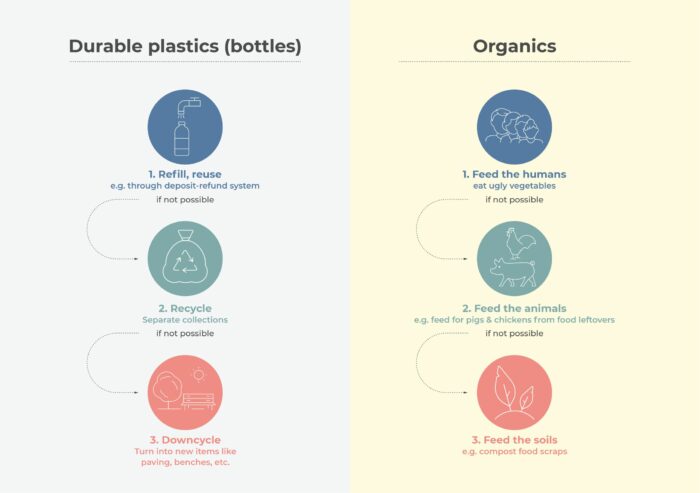Waste info
Why keep resources in the loop?
If we want to value materials, minimise littering, and reduce the loss of materials, we can:
- promote and adopt less wasteful habits and products,
- establish formal collection schemes,
- promote local recycling and reuse activities,
- establish markets for recycled materials and compost.
It is important to sharply cut the amount of waste scattered in cities, countrysides, waterways, and oceans. This is how we tackle the problem of plastic marine pollution, which has grown at a pace of 10 million tonnes each year. Garbage patches in the oceans, plastic entering the food webs and our drinking water, these are the main signs of a dramatic problem now at the top of the public agenda.
Sustainable management of waste doesn’t only reduce litter, minimise the need for landfills and incinerators and lower the environmental impacts and concerns. It also brings wider social benefits – job opportunities, increased income and living standards.
Some key facts and figures
- Going circular would mean a higher efficiency in the economic system: fewer resources used and lower expenditures for disposal of discards. Some estimates show impressive economic advantages of this “efficiency plan”: e.g. 1,8 trillion euros of economic benefits by 2030 for the EU switching from current practice to circular economy.
- Separate collection, recycling, composting, reuse and repair are labour-intensive activities. Managing resources through such activities, instead of disposal at landfill and incineration sites, would increase the occupational levels. For example, 1,1 million jobs could be created if the US aimed for recycling 75% of waste and composting through a Zero Waste approach. A report by RREUSE shows occupational figures for different options to manage 10.000 tonnes of waste/materials:
- 1 job at incinerators
- 6 jobs at landfills
- 36 jobs at recycling/composting sites
- 296 jobs at reuse centres
- Reducing waste, reusing and sending it to recycling and composting is also a great climate-mitigation measure. It helps to preserve the “embodied energy” of materials, i.e. the energy which has been used to extract, transport, transform, distribute them. As a consequence, reducing landfilling and incineration of waste also minimises greenhouse gases from the waste sector (estimated to be between 4 and 12% of the total generation of greenhouse gases) as can be seen from this graph:

Savings (negative values) of greenhouse gases or contribution to greenhouse gases (positive values) through waste prevention, recycling/composting or disposal of mixed waste (Source: EUNOMIA) - Circular management of resources contributes to many of the Sustainable Development Goals (SDGs) defined by the United Nations.
Steps to preserve resources
The best principle to embody this effort is the “cascading use of materials”. This can be defined as keeping the resources in the highest status for as long as possible, in practical terms the search for the use of waste that maximises its value. Here are two examples of how this principle works in practice:

The approach to move from linear to circular use of resources, can be described with the “4R’s” strategy, i.e. the combination of the following actions:
- Reduce (and refuse): choose goods and services that create less waste, refuse single use items (straws, bags, etc.) when not strictly needed.
- Reuse: choose durable products and use them again and again; give second life to stuff which is not useful anymore for you, but may still meet the needs of somebody else.
- Recycle: separate your waste by type and find a way to recycle (and compost) them.
- Rethink-Redesign: materials and items which can’t be reduced, reused, recycled or composted should all be redesigned by industries and made durable, reusable, recyclable.
Note: Attention should be paid to the importance of “waste audits” – analysing what kind of waste you create the most. It is a great way to get information for the next steps and connect the last “R” back to first one, creating an endless loop of implementation/testing/assessing/redesigning.
